SOE11531 Report: Scylace Plc Superstore and Acquisition Strategy
VerifiedAdded on 2022/11/29
|13
|3545
|225
Report
AI Summary
This report, prepared for Scylace Plc, a grocery retail chain, evaluates two alternative proposals for building a new superstore and a takeover bid for Helibeb Plc. The analysis considers two potential locations for the superstore, assessing each based on annual profit, average investment, and accounting rate of return. The report also examines the acquisition of Helibeb Plc using ratio analysis. The financial aspects considered include the issuance of bonds or equity shares for financing. The report recommends the best location for the new superstore, the optimal financing option, and the feasibility of acquiring Helibeb Plc. The methodologies used include annual profit calculations, average investment assessment, and accounting rate of return computations for the superstore locations, along with ratio analysis for evaluating the acquisition of Helibeb Plc, and the impact of different financing options on the company's financial health.
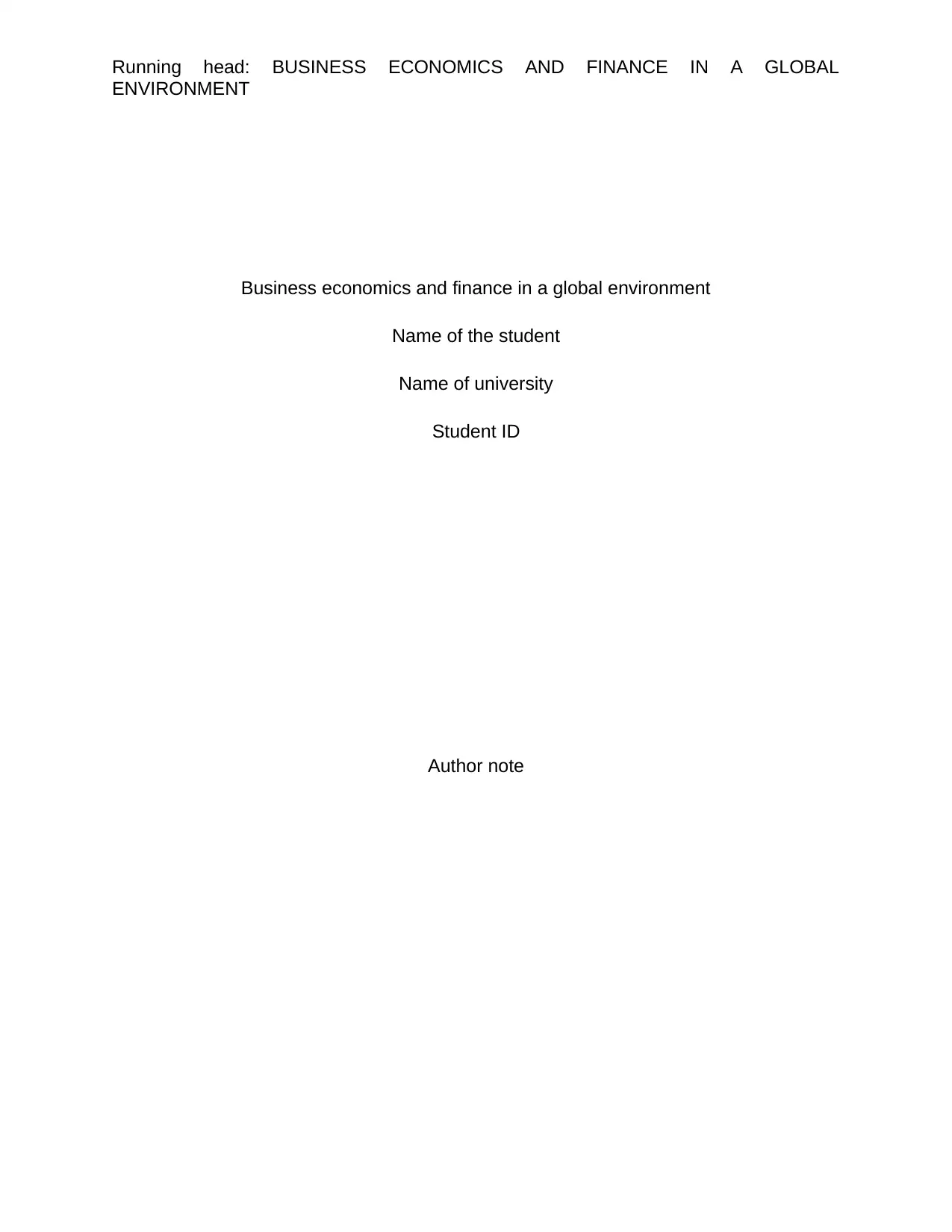
Running head: BUSINESS ECONOMICS AND FINANCE IN A GLOBAL
ENVIRONMENT
Business economics and finance in a global environment
Name of the student
Name of university
Student ID
Author note
ENVIRONMENT
Business economics and finance in a global environment
Name of the student
Name of university
Student ID
Author note
Paraphrase This Document
Need a fresh take? Get an instant paraphrase of this document with our AI Paraphraser
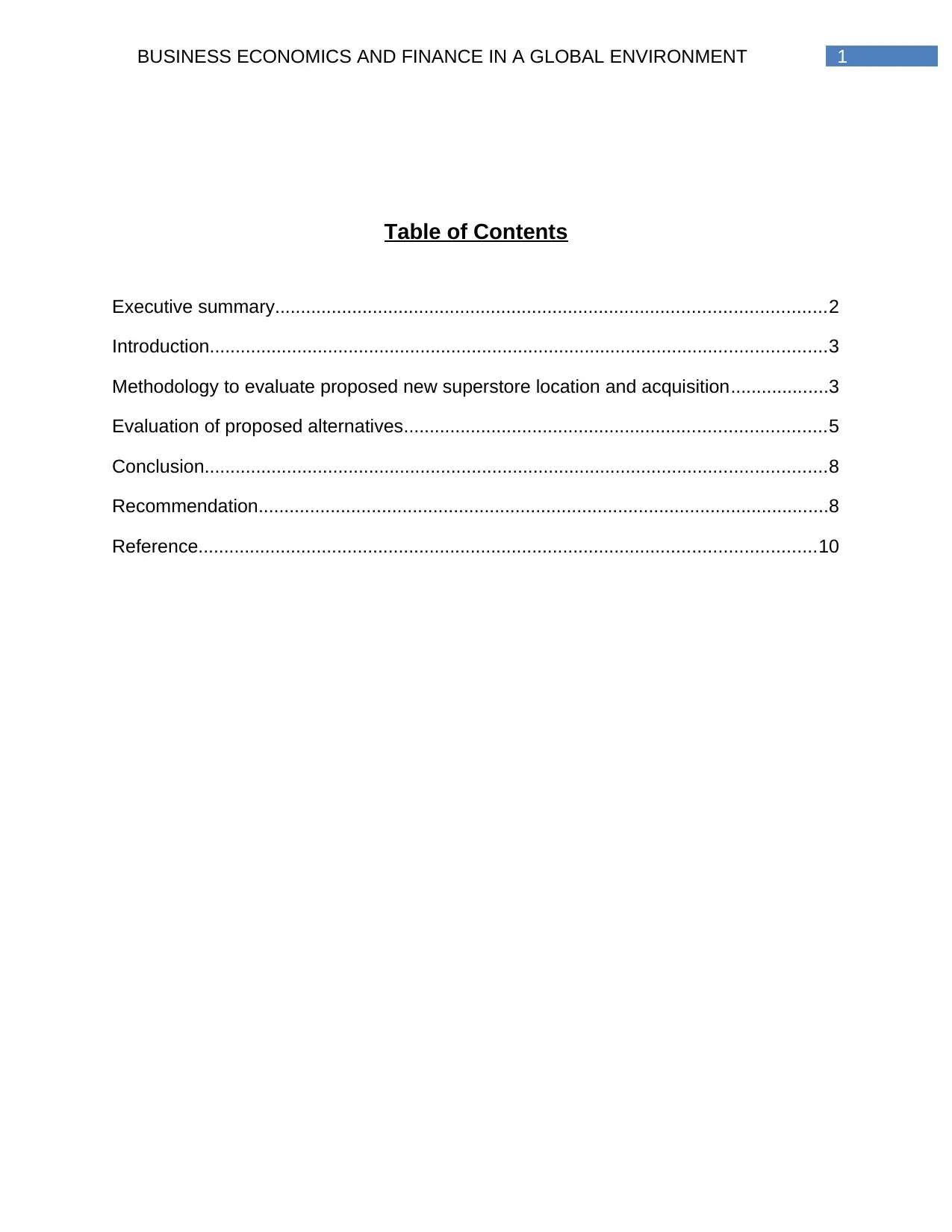
1BUSINESS ECONOMICS AND FINANCE IN A GLOBAL ENVIRONMENT
Table of Contents
Executive summary...........................................................................................................2
Introduction........................................................................................................................3
Methodology to evaluate proposed new superstore location and acquisition...................3
Evaluation of proposed alternatives..................................................................................5
Conclusion.........................................................................................................................8
Recommendation...............................................................................................................8
Reference........................................................................................................................10
Table of Contents
Executive summary...........................................................................................................2
Introduction........................................................................................................................3
Methodology to evaluate proposed new superstore location and acquisition...................3
Evaluation of proposed alternatives..................................................................................5
Conclusion.........................................................................................................................8
Recommendation...............................................................................................................8
Reference........................................................................................................................10
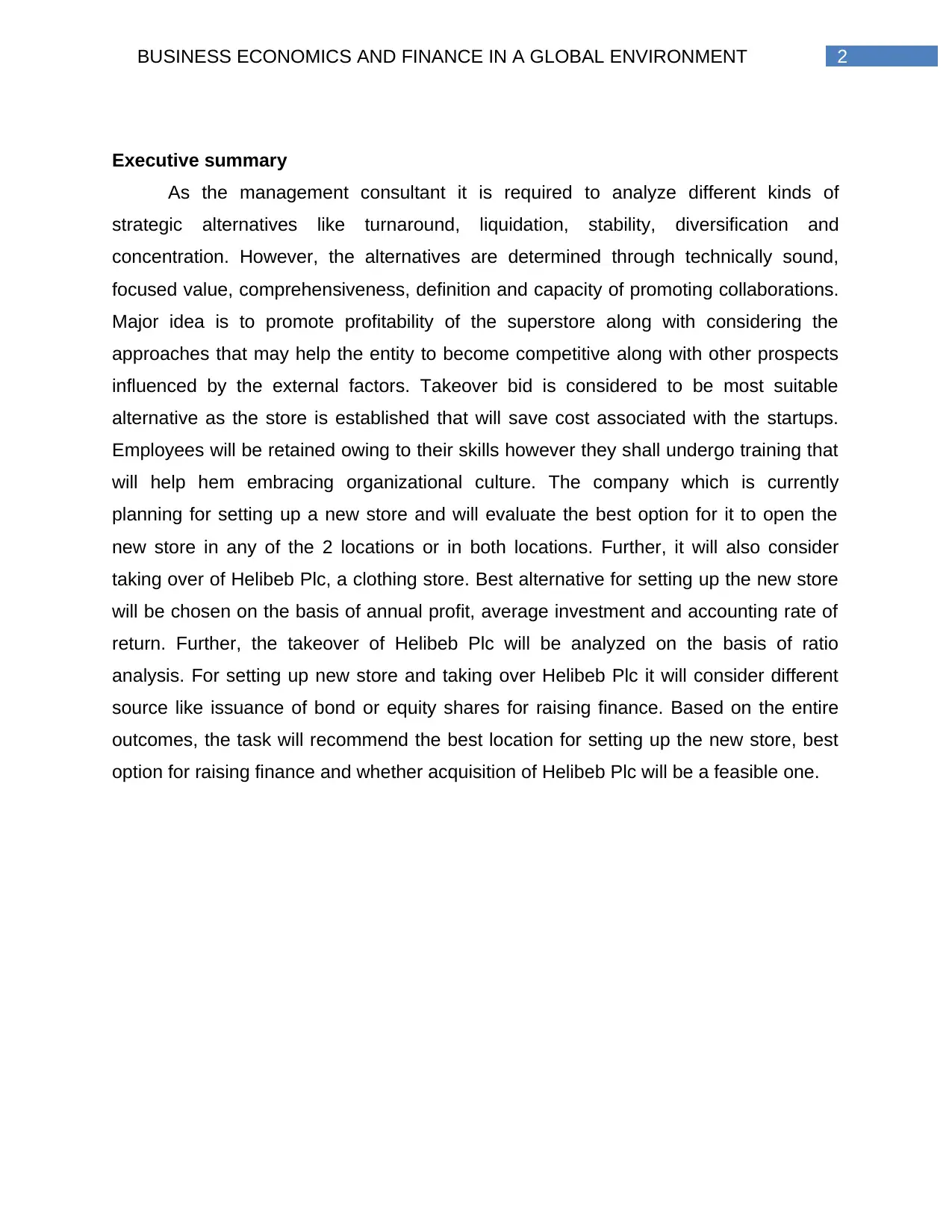
2BUSINESS ECONOMICS AND FINANCE IN A GLOBAL ENVIRONMENT
Executive summary
As the management consultant it is required to analyze different kinds of
strategic alternatives like turnaround, liquidation, stability, diversification and
concentration. However, the alternatives are determined through technically sound,
focused value, comprehensiveness, definition and capacity of promoting collaborations.
Major idea is to promote profitability of the superstore along with considering the
approaches that may help the entity to become competitive along with other prospects
influenced by the external factors. Takeover bid is considered to be most suitable
alternative as the store is established that will save cost associated with the startups.
Employees will be retained owing to their skills however they shall undergo training that
will help hem embracing organizational culture. The company which is currently
planning for setting up a new store and will evaluate the best option for it to open the
new store in any of the 2 locations or in both locations. Further, it will also consider
taking over of Helibeb Plc, a clothing store. Best alternative for setting up the new store
will be chosen on the basis of annual profit, average investment and accounting rate of
return. Further, the takeover of Helibeb Plc will be analyzed on the basis of ratio
analysis. For setting up new store and taking over Helibeb Plc it will consider different
source like issuance of bond or equity shares for raising finance. Based on the entire
outcomes, the task will recommend the best location for setting up the new store, best
option for raising finance and whether acquisition of Helibeb Plc will be a feasible one.
Executive summary
As the management consultant it is required to analyze different kinds of
strategic alternatives like turnaround, liquidation, stability, diversification and
concentration. However, the alternatives are determined through technically sound,
focused value, comprehensiveness, definition and capacity of promoting collaborations.
Major idea is to promote profitability of the superstore along with considering the
approaches that may help the entity to become competitive along with other prospects
influenced by the external factors. Takeover bid is considered to be most suitable
alternative as the store is established that will save cost associated with the startups.
Employees will be retained owing to their skills however they shall undergo training that
will help hem embracing organizational culture. The company which is currently
planning for setting up a new store and will evaluate the best option for it to open the
new store in any of the 2 locations or in both locations. Further, it will also consider
taking over of Helibeb Plc, a clothing store. Best alternative for setting up the new store
will be chosen on the basis of annual profit, average investment and accounting rate of
return. Further, the takeover of Helibeb Plc will be analyzed on the basis of ratio
analysis. For setting up new store and taking over Helibeb Plc it will consider different
source like issuance of bond or equity shares for raising finance. Based on the entire
outcomes, the task will recommend the best location for setting up the new store, best
option for raising finance and whether acquisition of Helibeb Plc will be a feasible one.
⊘ This is a preview!⊘
Do you want full access?
Subscribe today to unlock all pages.

Trusted by 1+ million students worldwide
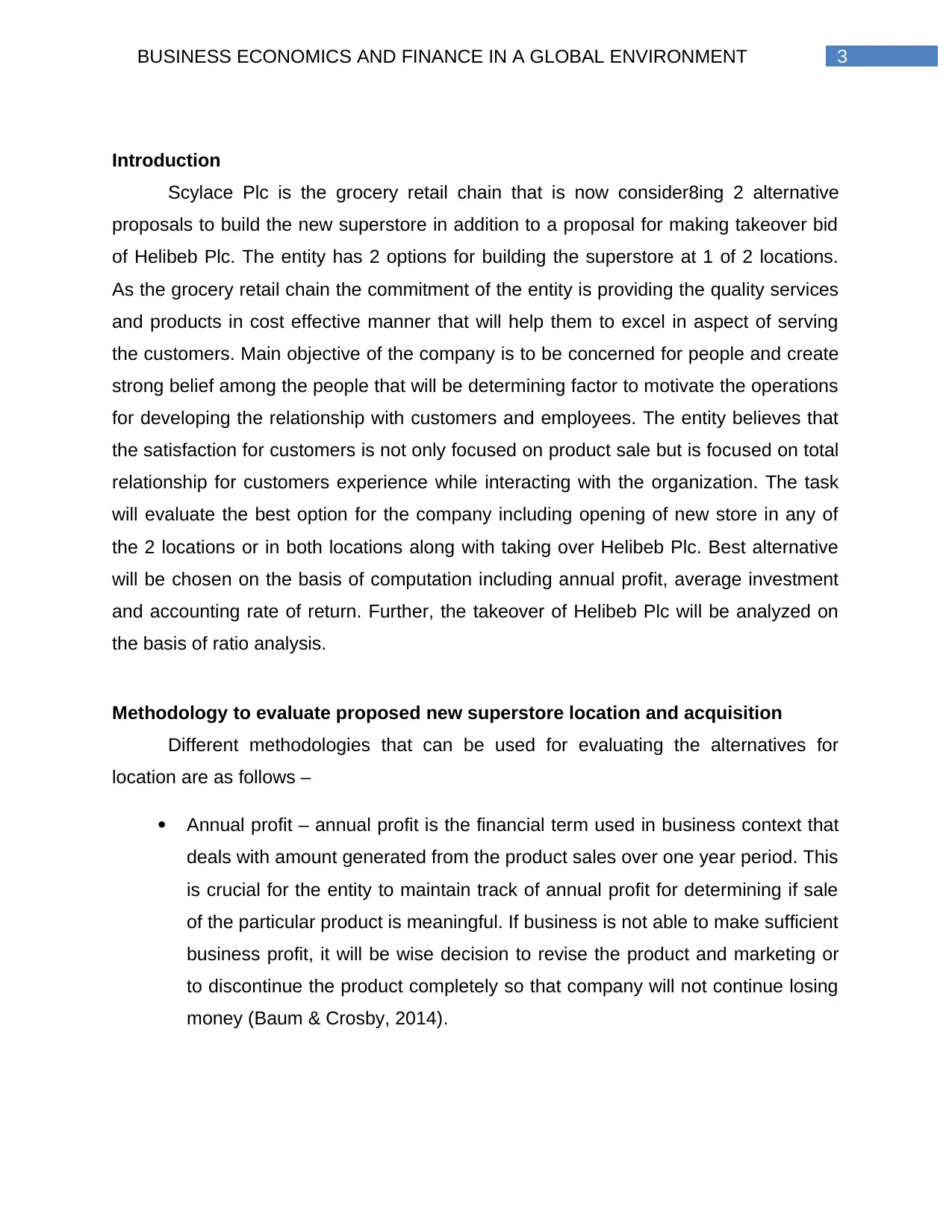
3BUSINESS ECONOMICS AND FINANCE IN A GLOBAL ENVIRONMENT
Introduction
Scylace Plc is the grocery retail chain that is now consider8ing 2 alternative
proposals to build the new superstore in addition to a proposal for making takeover bid
of Helibeb Plc. The entity has 2 options for building the superstore at 1 of 2 locations.
As the grocery retail chain the commitment of the entity is providing the quality services
and products in cost effective manner that will help them to excel in aspect of serving
the customers. Main objective of the company is to be concerned for people and create
strong belief among the people that will be determining factor to motivate the operations
for developing the relationship with customers and employees. The entity believes that
the satisfaction for customers is not only focused on product sale but is focused on total
relationship for customers experience while interacting with the organization. The task
will evaluate the best option for the company including opening of new store in any of
the 2 locations or in both locations along with taking over Helibeb Plc. Best alternative
will be chosen on the basis of computation including annual profit, average investment
and accounting rate of return. Further, the takeover of Helibeb Plc will be analyzed on
the basis of ratio analysis.
Methodology to evaluate proposed new superstore location and acquisition
Different methodologies that can be used for evaluating the alternatives for
location are as follows –
Annual profit – annual profit is the financial term used in business context that
deals with amount generated from the product sales over one year period. This
is crucial for the entity to maintain track of annual profit for determining if sale
of the particular product is meaningful. If business is not able to make sufficient
business profit, it will be wise decision to revise the product and marketing or
to discontinue the product completely so that company will not continue losing
money (Baum & Crosby, 2014).
Introduction
Scylace Plc is the grocery retail chain that is now consider8ing 2 alternative
proposals to build the new superstore in addition to a proposal for making takeover bid
of Helibeb Plc. The entity has 2 options for building the superstore at 1 of 2 locations.
As the grocery retail chain the commitment of the entity is providing the quality services
and products in cost effective manner that will help them to excel in aspect of serving
the customers. Main objective of the company is to be concerned for people and create
strong belief among the people that will be determining factor to motivate the operations
for developing the relationship with customers and employees. The entity believes that
the satisfaction for customers is not only focused on product sale but is focused on total
relationship for customers experience while interacting with the organization. The task
will evaluate the best option for the company including opening of new store in any of
the 2 locations or in both locations along with taking over Helibeb Plc. Best alternative
will be chosen on the basis of computation including annual profit, average investment
and accounting rate of return. Further, the takeover of Helibeb Plc will be analyzed on
the basis of ratio analysis.
Methodology to evaluate proposed new superstore location and acquisition
Different methodologies that can be used for evaluating the alternatives for
location are as follows –
Annual profit – annual profit is the financial term used in business context that
deals with amount generated from the product sales over one year period. This
is crucial for the entity to maintain track of annual profit for determining if sale
of the particular product is meaningful. If business is not able to make sufficient
business profit, it will be wise decision to revise the product and marketing or
to discontinue the product completely so that company will not continue losing
money (Baum & Crosby, 2014).
Paraphrase This Document
Need a fresh take? Get an instant paraphrase of this document with our AI Paraphraser
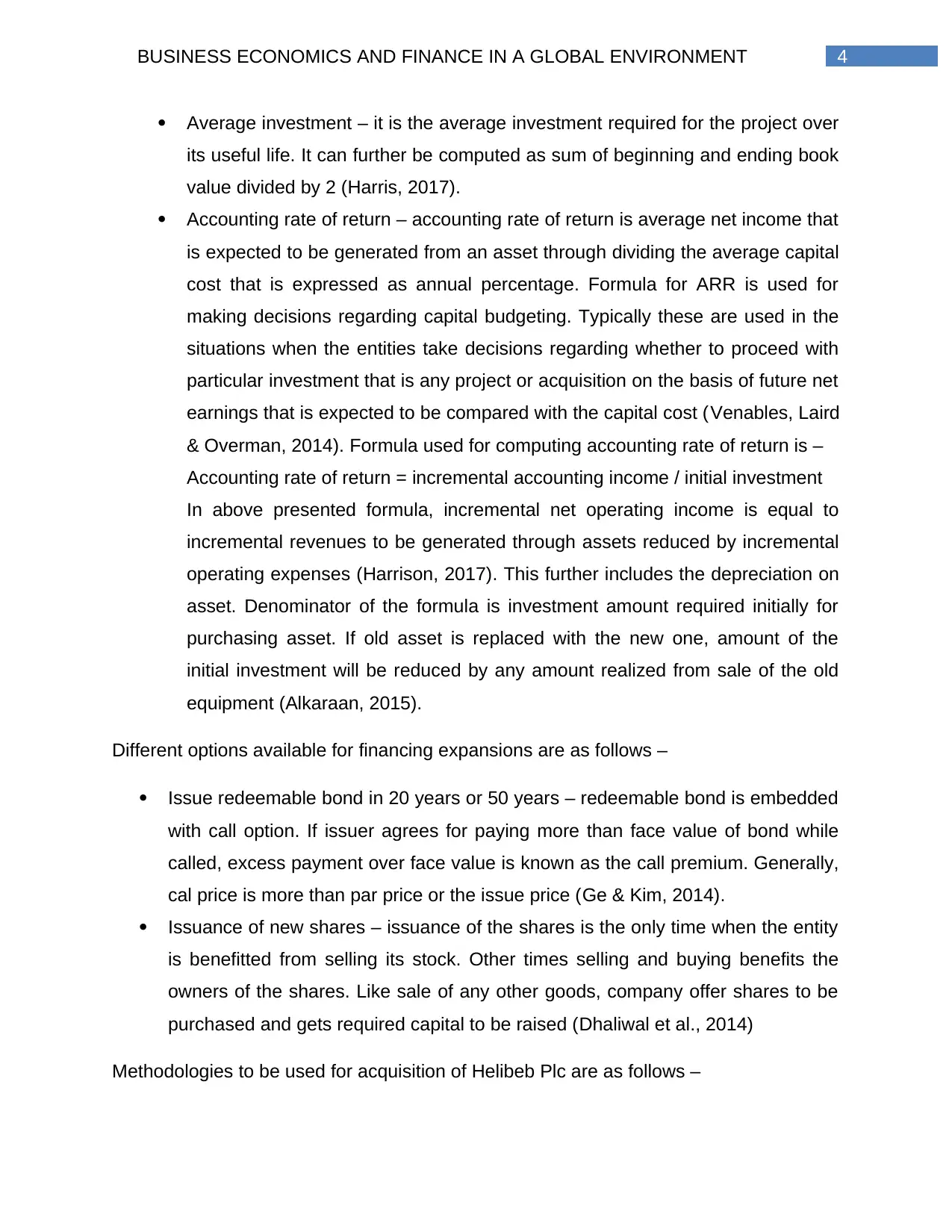
4BUSINESS ECONOMICS AND FINANCE IN A GLOBAL ENVIRONMENT
Average investment – it is the average investment required for the project over
its useful life. It can further be computed as sum of beginning and ending book
value divided by 2 (Harris, 2017).
Accounting rate of return – accounting rate of return is average net income that
is expected to be generated from an asset through dividing the average capital
cost that is expressed as annual percentage. Formula for ARR is used for
making decisions regarding capital budgeting. Typically these are used in the
situations when the entities take decisions regarding whether to proceed with
particular investment that is any project or acquisition on the basis of future net
earnings that is expected to be compared with the capital cost (Venables, Laird
& Overman, 2014). Formula used for computing accounting rate of return is –
Accounting rate of return = incremental accounting income / initial investment
In above presented formula, incremental net operating income is equal to
incremental revenues to be generated through assets reduced by incremental
operating expenses (Harrison, 2017). This further includes the depreciation on
asset. Denominator of the formula is investment amount required initially for
purchasing asset. If old asset is replaced with the new one, amount of the
initial investment will be reduced by any amount realized from sale of the old
equipment (Alkaraan, 2015).
Different options available for financing expansions are as follows –
Issue redeemable bond in 20 years or 50 years – redeemable bond is embedded
with call option. If issuer agrees for paying more than face value of bond while
called, excess payment over face value is known as the call premium. Generally,
cal price is more than par price or the issue price (Ge & Kim, 2014).
Issuance of new shares – issuance of the shares is the only time when the entity
is benefitted from selling its stock. Other times selling and buying benefits the
owners of the shares. Like sale of any other goods, company offer shares to be
purchased and gets required capital to be raised (Dhaliwal et al., 2014)
Methodologies to be used for acquisition of Helibeb Plc are as follows –
Average investment – it is the average investment required for the project over
its useful life. It can further be computed as sum of beginning and ending book
value divided by 2 (Harris, 2017).
Accounting rate of return – accounting rate of return is average net income that
is expected to be generated from an asset through dividing the average capital
cost that is expressed as annual percentage. Formula for ARR is used for
making decisions regarding capital budgeting. Typically these are used in the
situations when the entities take decisions regarding whether to proceed with
particular investment that is any project or acquisition on the basis of future net
earnings that is expected to be compared with the capital cost (Venables, Laird
& Overman, 2014). Formula used for computing accounting rate of return is –
Accounting rate of return = incremental accounting income / initial investment
In above presented formula, incremental net operating income is equal to
incremental revenues to be generated through assets reduced by incremental
operating expenses (Harrison, 2017). This further includes the depreciation on
asset. Denominator of the formula is investment amount required initially for
purchasing asset. If old asset is replaced with the new one, amount of the
initial investment will be reduced by any amount realized from sale of the old
equipment (Alkaraan, 2015).
Different options available for financing expansions are as follows –
Issue redeemable bond in 20 years or 50 years – redeemable bond is embedded
with call option. If issuer agrees for paying more than face value of bond while
called, excess payment over face value is known as the call premium. Generally,
cal price is more than par price or the issue price (Ge & Kim, 2014).
Issuance of new shares – issuance of the shares is the only time when the entity
is benefitted from selling its stock. Other times selling and buying benefits the
owners of the shares. Like sale of any other goods, company offer shares to be
purchased and gets required capital to be raised (Dhaliwal et al., 2014)
Methodologies to be used for acquisition of Helibeb Plc are as follows –
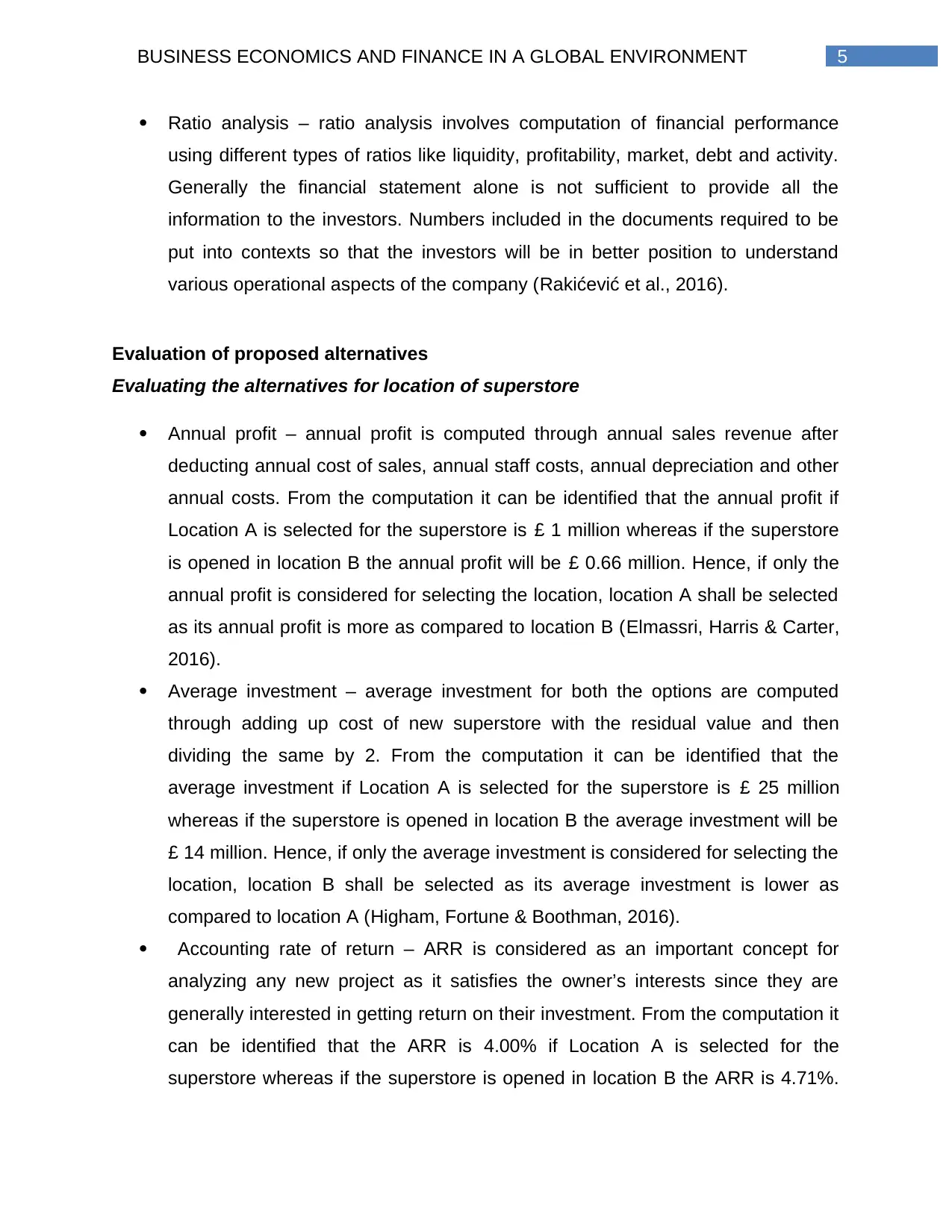
5BUSINESS ECONOMICS AND FINANCE IN A GLOBAL ENVIRONMENT
Ratio analysis – ratio analysis involves computation of financial performance
using different types of ratios like liquidity, profitability, market, debt and activity.
Generally the financial statement alone is not sufficient to provide all the
information to the investors. Numbers included in the documents required to be
put into contexts so that the investors will be in better position to understand
various operational aspects of the company (Rakićević et al., 2016).
Evaluation of proposed alternatives
Evaluating the alternatives for location of superstore
Annual profit – annual profit is computed through annual sales revenue after
deducting annual cost of sales, annual staff costs, annual depreciation and other
annual costs. From the computation it can be identified that the annual profit if
Location A is selected for the superstore is £ 1 million whereas if the superstore
is opened in location B the annual profit will be £ 0.66 million. Hence, if only the
annual profit is considered for selecting the location, location A shall be selected
as its annual profit is more as compared to location B (Elmassri, Harris & Carter,
2016).
Average investment – average investment for both the options are computed
through adding up cost of new superstore with the residual value and then
dividing the same by 2. From the computation it can be identified that the
average investment if Location A is selected for the superstore is £ 25 million
whereas if the superstore is opened in location B the average investment will be
£ 14 million. Hence, if only the average investment is considered for selecting the
location, location B shall be selected as its average investment is lower as
compared to location A (Higham, Fortune & Boothman, 2016).
Accounting rate of return – ARR is considered as an important concept for
analyzing any new project as it satisfies the owner’s interests since they are
generally interested in getting return on their investment. From the computation it
can be identified that the ARR is 4.00% if Location A is selected for the
superstore whereas if the superstore is opened in location B the ARR is 4.71%.
Ratio analysis – ratio analysis involves computation of financial performance
using different types of ratios like liquidity, profitability, market, debt and activity.
Generally the financial statement alone is not sufficient to provide all the
information to the investors. Numbers included in the documents required to be
put into contexts so that the investors will be in better position to understand
various operational aspects of the company (Rakićević et al., 2016).
Evaluation of proposed alternatives
Evaluating the alternatives for location of superstore
Annual profit – annual profit is computed through annual sales revenue after
deducting annual cost of sales, annual staff costs, annual depreciation and other
annual costs. From the computation it can be identified that the annual profit if
Location A is selected for the superstore is £ 1 million whereas if the superstore
is opened in location B the annual profit will be £ 0.66 million. Hence, if only the
annual profit is considered for selecting the location, location A shall be selected
as its annual profit is more as compared to location B (Elmassri, Harris & Carter,
2016).
Average investment – average investment for both the options are computed
through adding up cost of new superstore with the residual value and then
dividing the same by 2. From the computation it can be identified that the
average investment if Location A is selected for the superstore is £ 25 million
whereas if the superstore is opened in location B the average investment will be
£ 14 million. Hence, if only the average investment is considered for selecting the
location, location B shall be selected as its average investment is lower as
compared to location A (Higham, Fortune & Boothman, 2016).
Accounting rate of return – ARR is considered as an important concept for
analyzing any new project as it satisfies the owner’s interests since they are
generally interested in getting return on their investment. From the computation it
can be identified that the ARR is 4.00% if Location A is selected for the
superstore whereas if the superstore is opened in location B the ARR is 4.71%.
⊘ This is a preview!⊘
Do you want full access?
Subscribe today to unlock all pages.

Trusted by 1+ million students worldwide

6BUSINESS ECONOMICS AND FINANCE IN A GLOBAL ENVIRONMENT
Hence, if only the ARR is considered for selecting the location, location B shall
be selected as its ARR is higher as compared to location A (Schlegel, Frank &
Britzelmaier, 2016).
Evaluating the alternatives for raising finance
Issuance of bond redeemable in 20 years and 50 years – it is the percentage of
return paid the bond, note or any other fixed income security in case the
investors buys and holds till its maturity date (Dick-Nielsen & Rossi, 2018).
Computation of yield is dependent on face value of bond, its interest rate and
market price. If the entity raises finance through issuing bond that is redeemable
in 20 years, the yield of the same will be 3.33%. On the other hand, if the entity
raises finance through issuing bond that is redeemable in 50 years, the yield of
the same will be 5.05% (Bessembinder et al., 2018).
Issuance of equity shares – cost of equity capital is computed through dividing
the dividend amount by share price and adding the results with dividend growth.
Scylace Plc’s total asset is amounting to £ 312 million that includes £ 14 million
of cash and have liabilities amounting to £ 98 million (Dhaliwal et al., 2016). Cost
of equity is the return required by the company for deciding whether investment
meets the requirement of capital return. Generally the companies use the same
as the threshold for required return rate under capital budgeting (Hasan, Hossain
& Habib, 2015). Cost of equity reveals compensation demanded by the market in
return of owing the asset and carrying out ownership risk. Looking into the details
regarding issuance of new equity shares by the company for required finance it
can be identified that the cost of equity capital is 7.34% (Antoniou, Doukas &
Subrahmanyam, 2015).
Evaluating acquisition of Helibeb Plc
Ratio analysis –
Return on shareholder’s equity – ROE is used to measure financial performance
of the entity. It provides the investors with insights of the efficiency with which its
management is managing the money contributed by the shareholders. ROE of
Hence, if only the ARR is considered for selecting the location, location B shall
be selected as its ARR is higher as compared to location A (Schlegel, Frank &
Britzelmaier, 2016).
Evaluating the alternatives for raising finance
Issuance of bond redeemable in 20 years and 50 years – it is the percentage of
return paid the bond, note or any other fixed income security in case the
investors buys and holds till its maturity date (Dick-Nielsen & Rossi, 2018).
Computation of yield is dependent on face value of bond, its interest rate and
market price. If the entity raises finance through issuing bond that is redeemable
in 20 years, the yield of the same will be 3.33%. On the other hand, if the entity
raises finance through issuing bond that is redeemable in 50 years, the yield of
the same will be 5.05% (Bessembinder et al., 2018).
Issuance of equity shares – cost of equity capital is computed through dividing
the dividend amount by share price and adding the results with dividend growth.
Scylace Plc’s total asset is amounting to £ 312 million that includes £ 14 million
of cash and have liabilities amounting to £ 98 million (Dhaliwal et al., 2016). Cost
of equity is the return required by the company for deciding whether investment
meets the requirement of capital return. Generally the companies use the same
as the threshold for required return rate under capital budgeting (Hasan, Hossain
& Habib, 2015). Cost of equity reveals compensation demanded by the market in
return of owing the asset and carrying out ownership risk. Looking into the details
regarding issuance of new equity shares by the company for required finance it
can be identified that the cost of equity capital is 7.34% (Antoniou, Doukas &
Subrahmanyam, 2015).
Evaluating acquisition of Helibeb Plc
Ratio analysis –
Return on shareholder’s equity – ROE is used to measure financial performance
of the entity. It provides the investors with insights of the efficiency with which its
management is managing the money contributed by the shareholders. ROE of
Paraphrase This Document
Need a fresh take? Get an instant paraphrase of this document with our AI Paraphraser
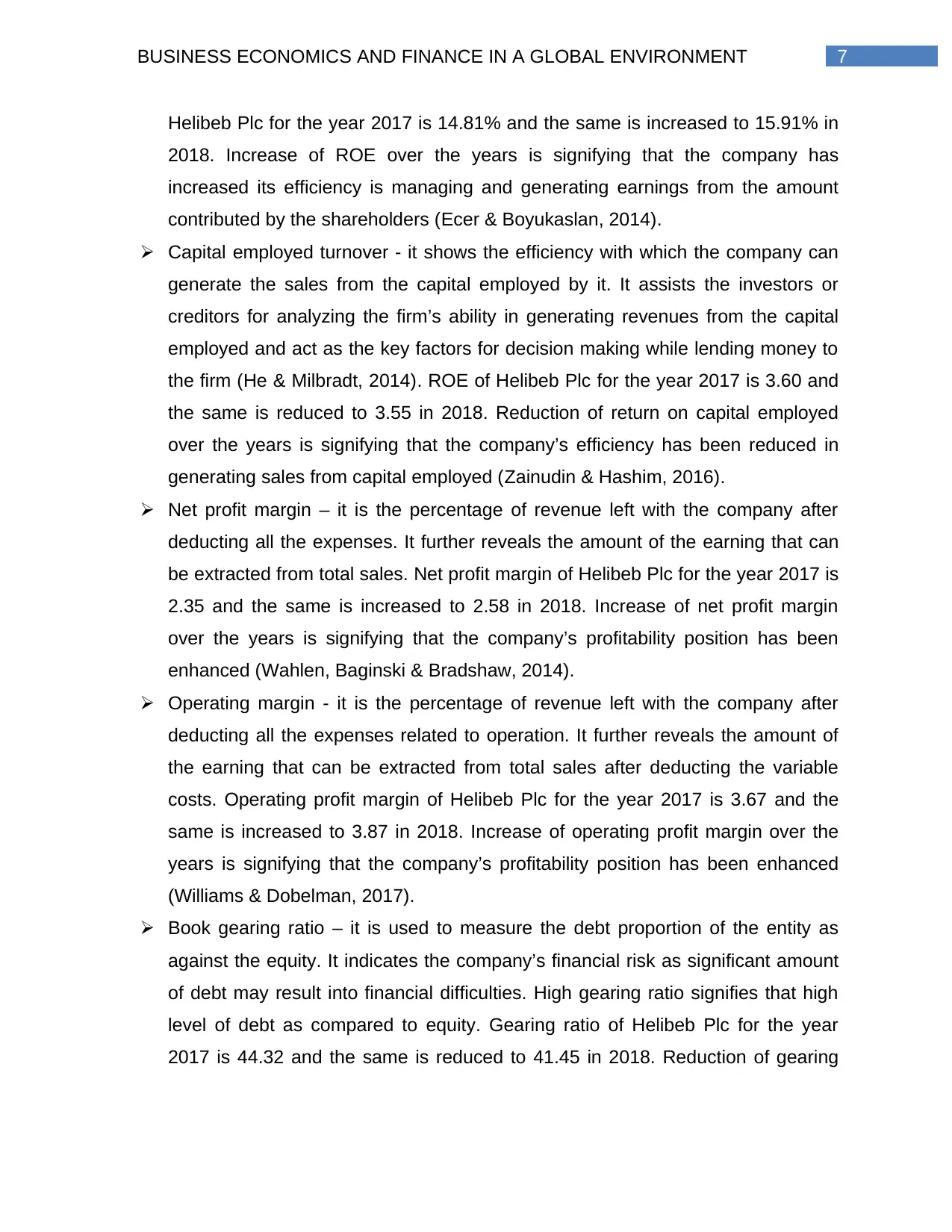
7BUSINESS ECONOMICS AND FINANCE IN A GLOBAL ENVIRONMENT
Helibeb Plc for the year 2017 is 14.81% and the same is increased to 15.91% in
2018. Increase of ROE over the years is signifying that the company has
increased its efficiency is managing and generating earnings from the amount
contributed by the shareholders (Ecer & Boyukaslan, 2014).
Capital employed turnover - it shows the efficiency with which the company can
generate the sales from the capital employed by it. It assists the investors or
creditors for analyzing the firm’s ability in generating revenues from the capital
employed and act as the key factors for decision making while lending money to
the firm (He & Milbradt, 2014). ROE of Helibeb Plc for the year 2017 is 3.60 and
the same is reduced to 3.55 in 2018. Reduction of return on capital employed
over the years is signifying that the company’s efficiency has been reduced in
generating sales from capital employed (Zainudin & Hashim, 2016).
Net profit margin – it is the percentage of revenue left with the company after
deducting all the expenses. It further reveals the amount of the earning that can
be extracted from total sales. Net profit margin of Helibeb Plc for the year 2017 is
2.35 and the same is increased to 2.58 in 2018. Increase of net profit margin
over the years is signifying that the company’s profitability position has been
enhanced (Wahlen, Baginski & Bradshaw, 2014).
Operating margin - it is the percentage of revenue left with the company after
deducting all the expenses related to operation. It further reveals the amount of
the earning that can be extracted from total sales after deducting the variable
costs. Operating profit margin of Helibeb Plc for the year 2017 is 3.67 and the
same is increased to 3.87 in 2018. Increase of operating profit margin over the
years is signifying that the company’s profitability position has been enhanced
(Williams & Dobelman, 2017).
Book gearing ratio – it is used to measure the debt proportion of the entity as
against the equity. It indicates the company’s financial risk as significant amount
of debt may result into financial difficulties. High gearing ratio signifies that high
level of debt as compared to equity. Gearing ratio of Helibeb Plc for the year
2017 is 44.32 and the same is reduced to 41.45 in 2018. Reduction of gearing
Helibeb Plc for the year 2017 is 14.81% and the same is increased to 15.91% in
2018. Increase of ROE over the years is signifying that the company has
increased its efficiency is managing and generating earnings from the amount
contributed by the shareholders (Ecer & Boyukaslan, 2014).
Capital employed turnover - it shows the efficiency with which the company can
generate the sales from the capital employed by it. It assists the investors or
creditors for analyzing the firm’s ability in generating revenues from the capital
employed and act as the key factors for decision making while lending money to
the firm (He & Milbradt, 2014). ROE of Helibeb Plc for the year 2017 is 3.60 and
the same is reduced to 3.55 in 2018. Reduction of return on capital employed
over the years is signifying that the company’s efficiency has been reduced in
generating sales from capital employed (Zainudin & Hashim, 2016).
Net profit margin – it is the percentage of revenue left with the company after
deducting all the expenses. It further reveals the amount of the earning that can
be extracted from total sales. Net profit margin of Helibeb Plc for the year 2017 is
2.35 and the same is increased to 2.58 in 2018. Increase of net profit margin
over the years is signifying that the company’s profitability position has been
enhanced (Wahlen, Baginski & Bradshaw, 2014).
Operating margin - it is the percentage of revenue left with the company after
deducting all the expenses related to operation. It further reveals the amount of
the earning that can be extracted from total sales after deducting the variable
costs. Operating profit margin of Helibeb Plc for the year 2017 is 3.67 and the
same is increased to 3.87 in 2018. Increase of operating profit margin over the
years is signifying that the company’s profitability position has been enhanced
(Williams & Dobelman, 2017).
Book gearing ratio – it is used to measure the debt proportion of the entity as
against the equity. It indicates the company’s financial risk as significant amount
of debt may result into financial difficulties. High gearing ratio signifies that high
level of debt as compared to equity. Gearing ratio of Helibeb Plc for the year
2017 is 44.32 and the same is reduced to 41.45 in 2018. Reduction of gearing
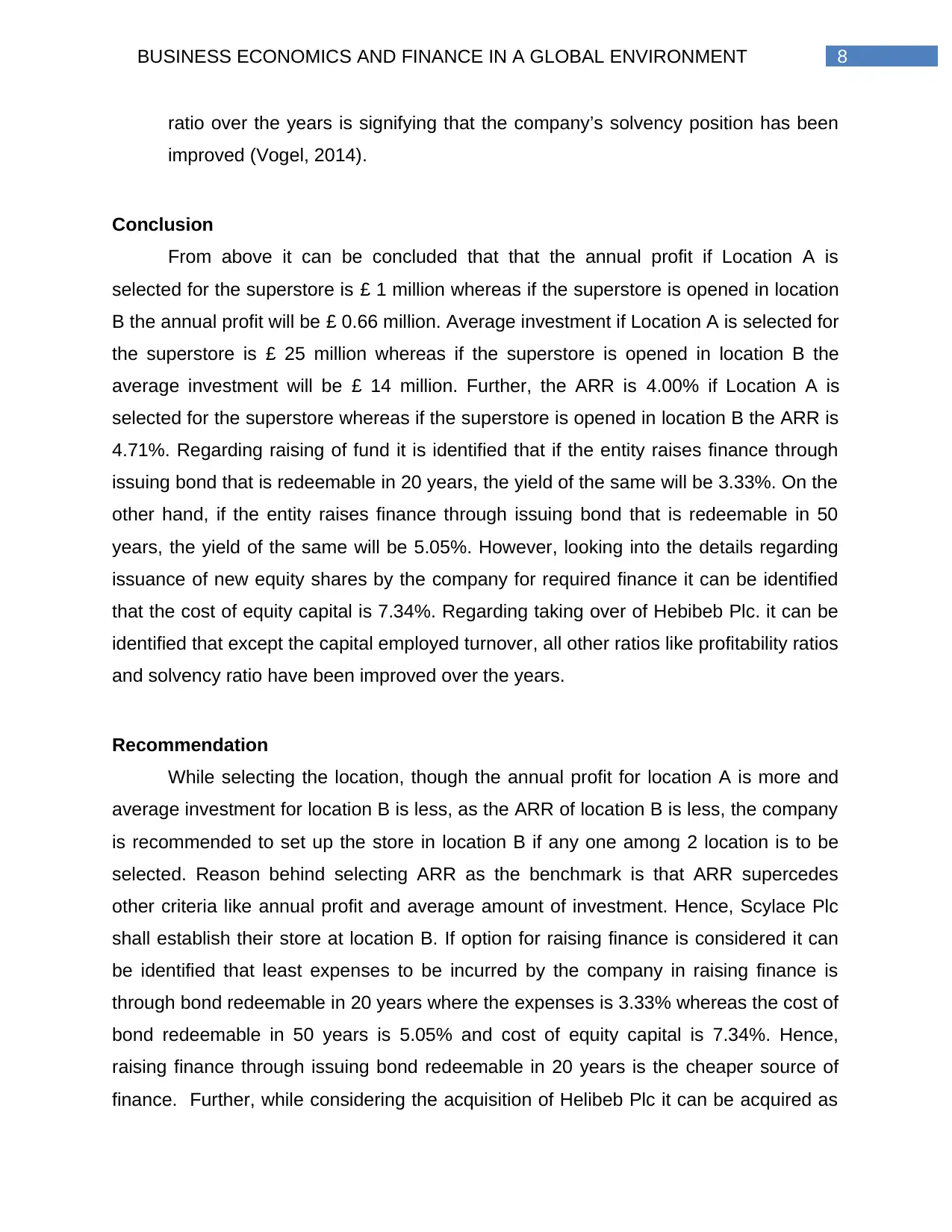
8BUSINESS ECONOMICS AND FINANCE IN A GLOBAL ENVIRONMENT
ratio over the years is signifying that the company’s solvency position has been
improved (Vogel, 2014).
Conclusion
From above it can be concluded that that the annual profit if Location A is
selected for the superstore is £ 1 million whereas if the superstore is opened in location
B the annual profit will be £ 0.66 million. Average investment if Location A is selected for
the superstore is £ 25 million whereas if the superstore is opened in location B the
average investment will be £ 14 million. Further, the ARR is 4.00% if Location A is
selected for the superstore whereas if the superstore is opened in location B the ARR is
4.71%. Regarding raising of fund it is identified that if the entity raises finance through
issuing bond that is redeemable in 20 years, the yield of the same will be 3.33%. On the
other hand, if the entity raises finance through issuing bond that is redeemable in 50
years, the yield of the same will be 5.05%. However, looking into the details regarding
issuance of new equity shares by the company for required finance it can be identified
that the cost of equity capital is 7.34%. Regarding taking over of Hebibeb Plc. it can be
identified that except the capital employed turnover, all other ratios like profitability ratios
and solvency ratio have been improved over the years.
Recommendation
While selecting the location, though the annual profit for location A is more and
average investment for location B is less, as the ARR of location B is less, the company
is recommended to set up the store in location B if any one among 2 location is to be
selected. Reason behind selecting ARR as the benchmark is that ARR supercedes
other criteria like annual profit and average amount of investment. Hence, Scylace Plc
shall establish their store at location B. If option for raising finance is considered it can
be identified that least expenses to be incurred by the company in raising finance is
through bond redeemable in 20 years where the expenses is 3.33% whereas the cost of
bond redeemable in 50 years is 5.05% and cost of equity capital is 7.34%. Hence,
raising finance through issuing bond redeemable in 20 years is the cheaper source of
finance. Further, while considering the acquisition of Helibeb Plc it can be acquired as
ratio over the years is signifying that the company’s solvency position has been
improved (Vogel, 2014).
Conclusion
From above it can be concluded that that the annual profit if Location A is
selected for the superstore is £ 1 million whereas if the superstore is opened in location
B the annual profit will be £ 0.66 million. Average investment if Location A is selected for
the superstore is £ 25 million whereas if the superstore is opened in location B the
average investment will be £ 14 million. Further, the ARR is 4.00% if Location A is
selected for the superstore whereas if the superstore is opened in location B the ARR is
4.71%. Regarding raising of fund it is identified that if the entity raises finance through
issuing bond that is redeemable in 20 years, the yield of the same will be 3.33%. On the
other hand, if the entity raises finance through issuing bond that is redeemable in 50
years, the yield of the same will be 5.05%. However, looking into the details regarding
issuance of new equity shares by the company for required finance it can be identified
that the cost of equity capital is 7.34%. Regarding taking over of Hebibeb Plc. it can be
identified that except the capital employed turnover, all other ratios like profitability ratios
and solvency ratio have been improved over the years.
Recommendation
While selecting the location, though the annual profit for location A is more and
average investment for location B is less, as the ARR of location B is less, the company
is recommended to set up the store in location B if any one among 2 location is to be
selected. Reason behind selecting ARR as the benchmark is that ARR supercedes
other criteria like annual profit and average amount of investment. Hence, Scylace Plc
shall establish their store at location B. If option for raising finance is considered it can
be identified that least expenses to be incurred by the company in raising finance is
through bond redeemable in 20 years where the expenses is 3.33% whereas the cost of
bond redeemable in 50 years is 5.05% and cost of equity capital is 7.34%. Hence,
raising finance through issuing bond redeemable in 20 years is the cheaper source of
finance. Further, while considering the acquisition of Helibeb Plc it can be acquired as
⊘ This is a preview!⊘
Do you want full access?
Subscribe today to unlock all pages.

Trusted by 1+ million students worldwide
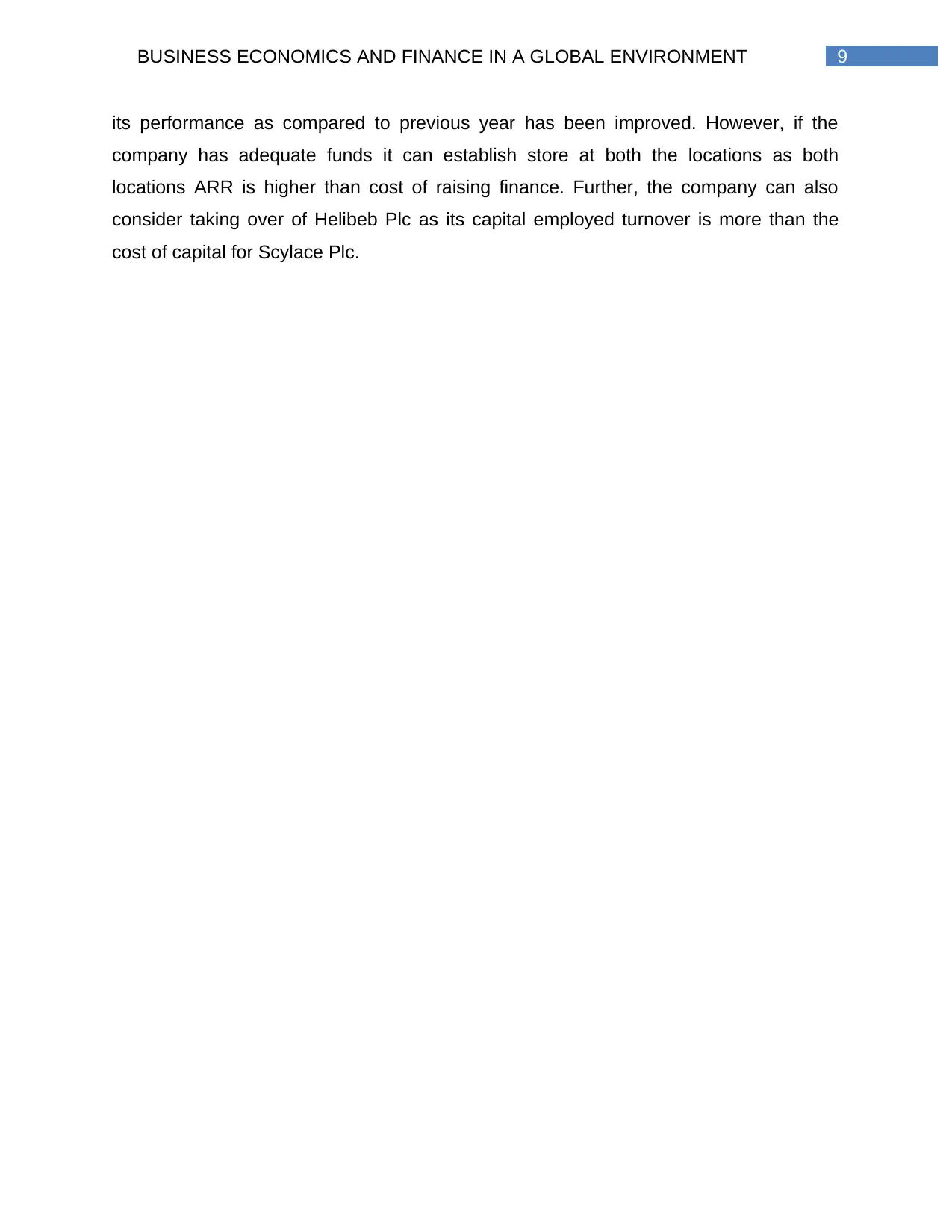
9BUSINESS ECONOMICS AND FINANCE IN A GLOBAL ENVIRONMENT
its performance as compared to previous year has been improved. However, if the
company has adequate funds it can establish store at both the locations as both
locations ARR is higher than cost of raising finance. Further, the company can also
consider taking over of Helibeb Plc as its capital employed turnover is more than the
cost of capital for Scylace Plc.
its performance as compared to previous year has been improved. However, if the
company has adequate funds it can establish store at both the locations as both
locations ARR is higher than cost of raising finance. Further, the company can also
consider taking over of Helibeb Plc as its capital employed turnover is more than the
cost of capital for Scylace Plc.
Paraphrase This Document
Need a fresh take? Get an instant paraphrase of this document with our AI Paraphraser
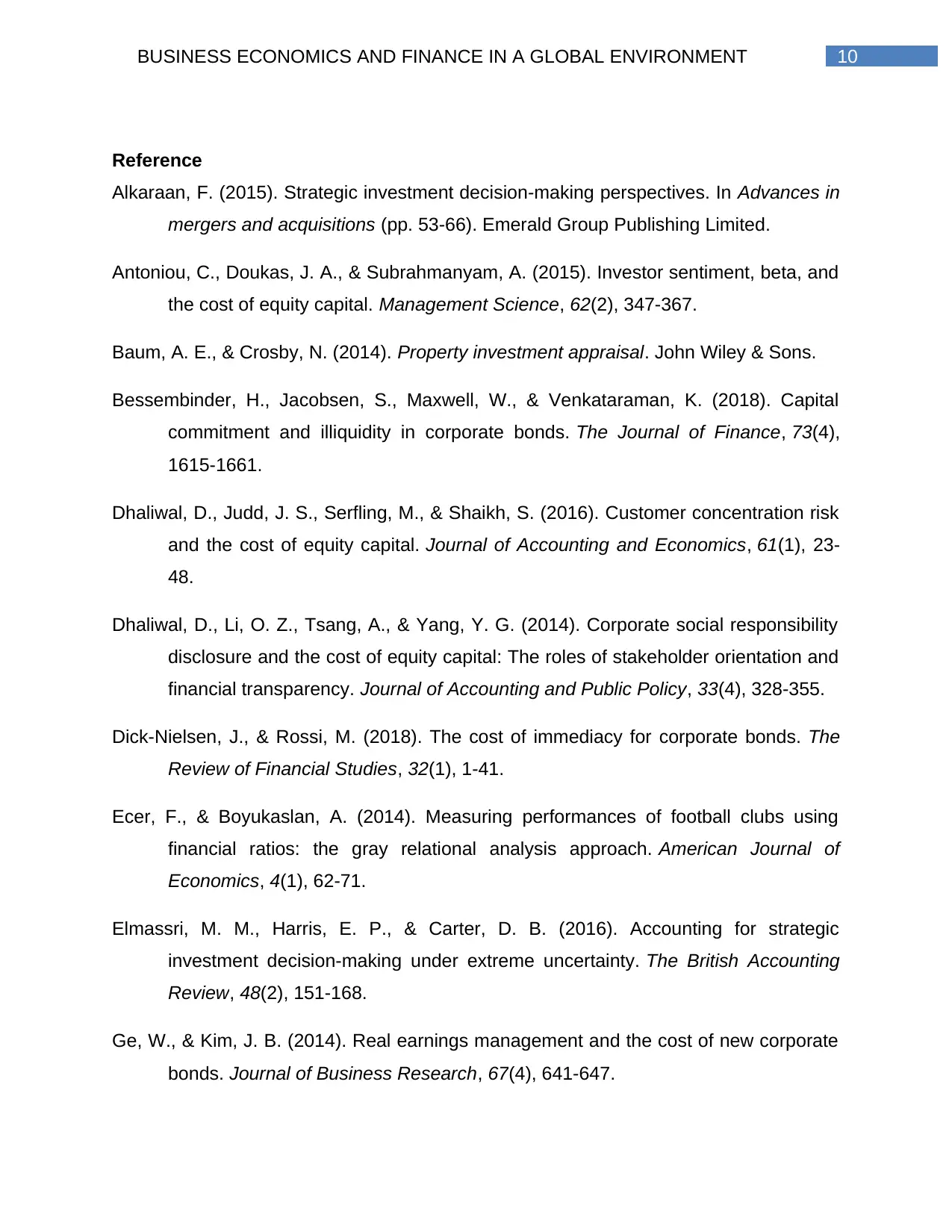
10BUSINESS ECONOMICS AND FINANCE IN A GLOBAL ENVIRONMENT
Reference
Alkaraan, F. (2015). Strategic investment decision-making perspectives. In Advances in
mergers and acquisitions (pp. 53-66). Emerald Group Publishing Limited.
Antoniou, C., Doukas, J. A., & Subrahmanyam, A. (2015). Investor sentiment, beta, and
the cost of equity capital. Management Science, 62(2), 347-367.
Baum, A. E., & Crosby, N. (2014). Property investment appraisal. John Wiley & Sons.
Bessembinder, H., Jacobsen, S., Maxwell, W., & Venkataraman, K. (2018). Capital
commitment and illiquidity in corporate bonds. The Journal of Finance, 73(4),
1615-1661.
Dhaliwal, D., Judd, J. S., Serfling, M., & Shaikh, S. (2016). Customer concentration risk
and the cost of equity capital. Journal of Accounting and Economics, 61(1), 23-
48.
Dhaliwal, D., Li, O. Z., Tsang, A., & Yang, Y. G. (2014). Corporate social responsibility
disclosure and the cost of equity capital: The roles of stakeholder orientation and
financial transparency. Journal of Accounting and Public Policy, 33(4), 328-355.
Dick-Nielsen, J., & Rossi, M. (2018). The cost of immediacy for corporate bonds. The
Review of Financial Studies, 32(1), 1-41.
Ecer, F., & Boyukaslan, A. (2014). Measuring performances of football clubs using
financial ratios: the gray relational analysis approach. American Journal of
Economics, 4(1), 62-71.
Elmassri, M. M., Harris, E. P., & Carter, D. B. (2016). Accounting for strategic
investment decision-making under extreme uncertainty. The British Accounting
Review, 48(2), 151-168.
Ge, W., & Kim, J. B. (2014). Real earnings management and the cost of new corporate
bonds. Journal of Business Research, 67(4), 641-647.
Reference
Alkaraan, F. (2015). Strategic investment decision-making perspectives. In Advances in
mergers and acquisitions (pp. 53-66). Emerald Group Publishing Limited.
Antoniou, C., Doukas, J. A., & Subrahmanyam, A. (2015). Investor sentiment, beta, and
the cost of equity capital. Management Science, 62(2), 347-367.
Baum, A. E., & Crosby, N. (2014). Property investment appraisal. John Wiley & Sons.
Bessembinder, H., Jacobsen, S., Maxwell, W., & Venkataraman, K. (2018). Capital
commitment and illiquidity in corporate bonds. The Journal of Finance, 73(4),
1615-1661.
Dhaliwal, D., Judd, J. S., Serfling, M., & Shaikh, S. (2016). Customer concentration risk
and the cost of equity capital. Journal of Accounting and Economics, 61(1), 23-
48.
Dhaliwal, D., Li, O. Z., Tsang, A., & Yang, Y. G. (2014). Corporate social responsibility
disclosure and the cost of equity capital: The roles of stakeholder orientation and
financial transparency. Journal of Accounting and Public Policy, 33(4), 328-355.
Dick-Nielsen, J., & Rossi, M. (2018). The cost of immediacy for corporate bonds. The
Review of Financial Studies, 32(1), 1-41.
Ecer, F., & Boyukaslan, A. (2014). Measuring performances of football clubs using
financial ratios: the gray relational analysis approach. American Journal of
Economics, 4(1), 62-71.
Elmassri, M. M., Harris, E. P., & Carter, D. B. (2016). Accounting for strategic
investment decision-making under extreme uncertainty. The British Accounting
Review, 48(2), 151-168.
Ge, W., & Kim, J. B. (2014). Real earnings management and the cost of new corporate
bonds. Journal of Business Research, 67(4), 641-647.
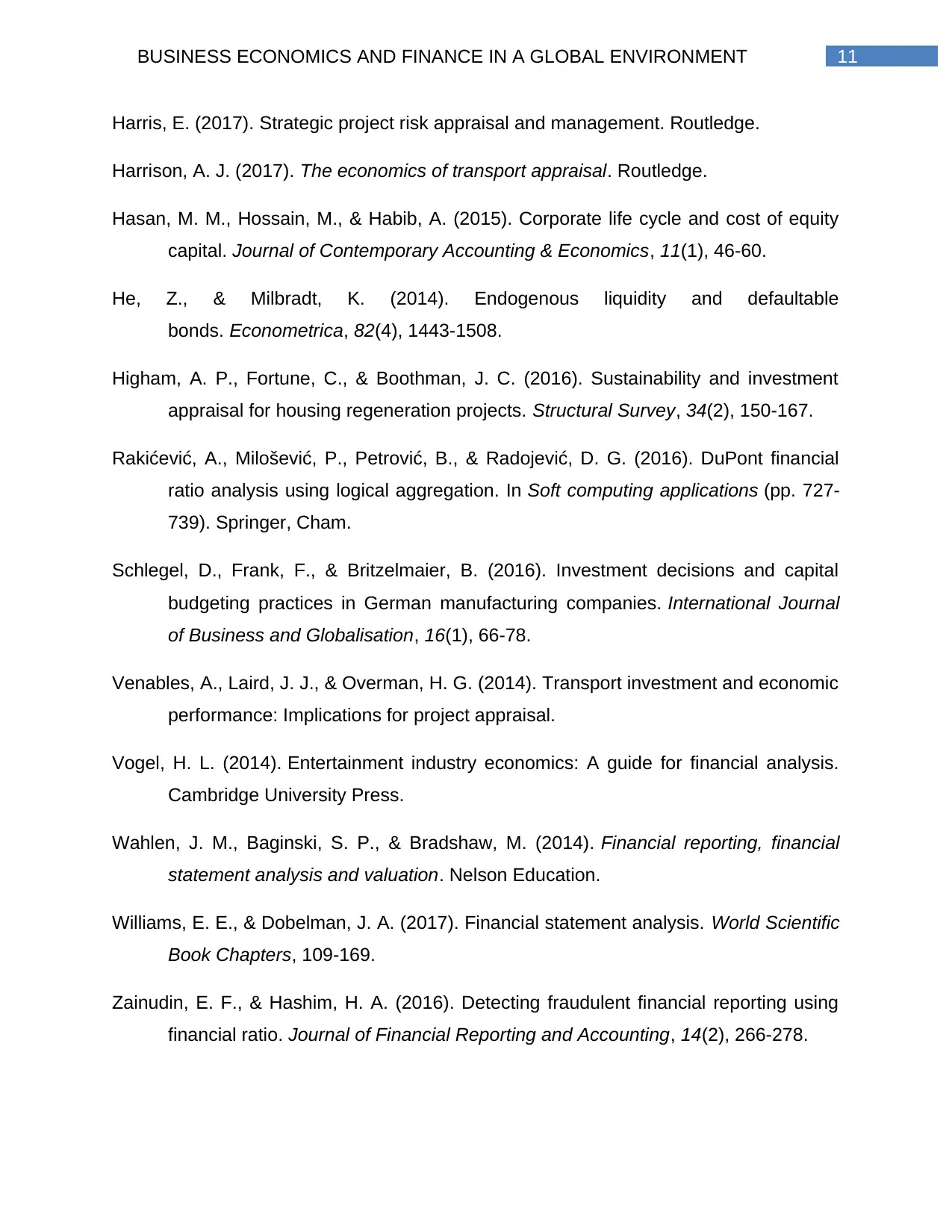
11BUSINESS ECONOMICS AND FINANCE IN A GLOBAL ENVIRONMENT
Harris, E. (2017). Strategic project risk appraisal and management. Routledge.
Harrison, A. J. (2017). The economics of transport appraisal. Routledge.
Hasan, M. M., Hossain, M., & Habib, A. (2015). Corporate life cycle and cost of equity
capital. Journal of Contemporary Accounting & Economics, 11(1), 46-60.
He, Z., & Milbradt, K. (2014). Endogenous liquidity and defaultable
bonds. Econometrica, 82(4), 1443-1508.
Higham, A. P., Fortune, C., & Boothman, J. C. (2016). Sustainability and investment
appraisal for housing regeneration projects. Structural Survey, 34(2), 150-167.
Rakićević, A., Milošević, P., Petrović, B., & Radojević, D. G. (2016). DuPont financial
ratio analysis using logical aggregation. In Soft computing applications (pp. 727-
739). Springer, Cham.
Schlegel, D., Frank, F., & Britzelmaier, B. (2016). Investment decisions and capital
budgeting practices in German manufacturing companies. International Journal
of Business and Globalisation, 16(1), 66-78.
Venables, A., Laird, J. J., & Overman, H. G. (2014). Transport investment and economic
performance: Implications for project appraisal.
Vogel, H. L. (2014). Entertainment industry economics: A guide for financial analysis.
Cambridge University Press.
Wahlen, J. M., Baginski, S. P., & Bradshaw, M. (2014). Financial reporting, financial
statement analysis and valuation. Nelson Education.
Williams, E. E., & Dobelman, J. A. (2017). Financial statement analysis. World Scientific
Book Chapters, 109-169.
Zainudin, E. F., & Hashim, H. A. (2016). Detecting fraudulent financial reporting using
financial ratio. Journal of Financial Reporting and Accounting, 14(2), 266-278.
Harris, E. (2017). Strategic project risk appraisal and management. Routledge.
Harrison, A. J. (2017). The economics of transport appraisal. Routledge.
Hasan, M. M., Hossain, M., & Habib, A. (2015). Corporate life cycle and cost of equity
capital. Journal of Contemporary Accounting & Economics, 11(1), 46-60.
He, Z., & Milbradt, K. (2014). Endogenous liquidity and defaultable
bonds. Econometrica, 82(4), 1443-1508.
Higham, A. P., Fortune, C., & Boothman, J. C. (2016). Sustainability and investment
appraisal for housing regeneration projects. Structural Survey, 34(2), 150-167.
Rakićević, A., Milošević, P., Petrović, B., & Radojević, D. G. (2016). DuPont financial
ratio analysis using logical aggregation. In Soft computing applications (pp. 727-
739). Springer, Cham.
Schlegel, D., Frank, F., & Britzelmaier, B. (2016). Investment decisions and capital
budgeting practices in German manufacturing companies. International Journal
of Business and Globalisation, 16(1), 66-78.
Venables, A., Laird, J. J., & Overman, H. G. (2014). Transport investment and economic
performance: Implications for project appraisal.
Vogel, H. L. (2014). Entertainment industry economics: A guide for financial analysis.
Cambridge University Press.
Wahlen, J. M., Baginski, S. P., & Bradshaw, M. (2014). Financial reporting, financial
statement analysis and valuation. Nelson Education.
Williams, E. E., & Dobelman, J. A. (2017). Financial statement analysis. World Scientific
Book Chapters, 109-169.
Zainudin, E. F., & Hashim, H. A. (2016). Detecting fraudulent financial reporting using
financial ratio. Journal of Financial Reporting and Accounting, 14(2), 266-278.
⊘ This is a preview!⊘
Do you want full access?
Subscribe today to unlock all pages.

Trusted by 1+ million students worldwide
1 out of 13
Related Documents
Your All-in-One AI-Powered Toolkit for Academic Success.
+13062052269
info@desklib.com
Available 24*7 on WhatsApp / Email
![[object Object]](/_next/static/media/star-bottom.7253800d.svg)
Unlock your academic potential
Copyright © 2020–2026 A2Z Services. All Rights Reserved. Developed and managed by ZUCOL.





